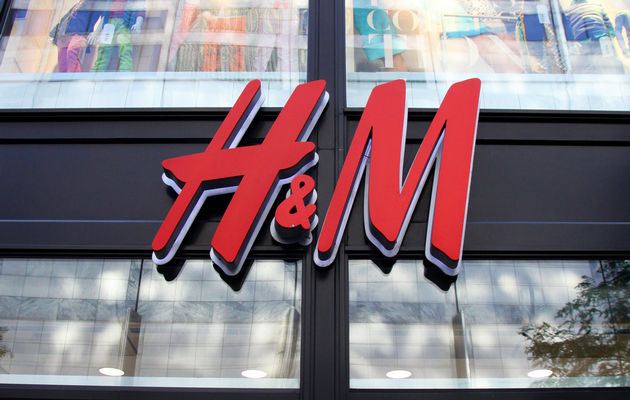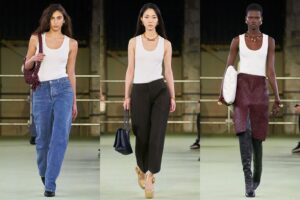I met her two years ago when sustainable fashion was still nascent and she was interviewing bloggers for her dissertation. Finding recycled apparel was extremely difficult back then. In fact, it was virtually impossible at times. Since then, we’ve stayed in touch and she’s become someone I call to go deep into sustainable fashion. Nadia understands the underpinnings, intricacies, and nuances of the industry better than many folks who work in it. Especially because she was an early adopter. Sustainable fashion is something that more and more stores are trying to do because of our current climate. From jumpers, to sustainable underwear from places like https://www.barbieinablender.org/bamboo-underwear-for-women/ more and more businesses are taking the environment into consideration when it comes to designing products. If you want to start your own journey with this, then this list of environmentally sustainable clothing brands can help you see what is best to wear and why. Eco-friendly fabrics are said to be made from natural or recycled materials, with an emphasis on minimizing harm to the environment through the process of production, fiber properties, etc. If you are at sixes and sevens whether sustainable fabrics are as comfortable as normal fabrics, you might want to start with something like a pair of sustainable socks or scarves.
On one such call, we were chatting about H&M [they had just dropped their 2017 Conscious Collection] and our mixed feelings about the powerhouse brand. It’s the name everyone drops when they hear we work in sustainable fashion. “Oh, so you promote the Conscious Collection?!” “Umm….not exactly.”
It’s nice to have someone both understand and laugh about this with me. But I’m also serious about uncovering the truth. Is H&M really sustainable? Or is this “craze for conscious” total malarkey? After writing and defending all 356 pages of her dissertation – a tome by ethical fashion standards – Nadia is an expert on H&M. I’m excited to feature a part of her research, which we’ve abridged and updated. I hope you find it illuminating and use in your quest toward conscious greatness.[/vc_column_text][vc_separator][vc_column_text]The fashion industry, which contributes annually over $2.5 trillion to the global economy and employs over 60 million people worldwide, has enormous potential to make the world more sustainable.
But this won’t happen overnight. How does one intervene given our capitalist system and consumer culture in the US? What should sustainable fashion advocates make of a company like H&M, a gigantic multinational and household name, that, on one hand, has been criticized for greenwashing, while simultaneously lauded for being a fast-fashion game-changer?
This is exactly what I asked the dozens of bloggers, organizers, and creatives in the ethical fashion movement while conducting my dissertation research on advocacy strategies and interventions in the fashion industry at UNC-Chapel Hill. [/vc_column_text][/vc_column][/vc_row][vc_row][vc_column][vc_column_text]
H&M: Paradoxes of Sustainable Fashion
In recent years, H&M has committed to several sustainability and labor initiatives, like the legally binding Bangladesh Safety Accord. Despite this, the company has been widely criticized. Take their ‘Conscious Collection’ as an example. It’s made from 50 percent sustainable materials, like recycled polyester and organic cotton, but because the collection itself is so small, H&M’s total use of recycled materials is still less than one percent. (from Kasi: pg. 17 if you’re hunting on that pdf).
Likewise, they’ve been praised as the number one buyer of organic cotton in the world, pledging to go 100 percent by 2020. Yet the most recent stats reveal that only 13.5 percent of H&M’s cotton is currently organic. Given this, it’s unlikely they will reach their lofty goal in three years.
Then, there’s the blatant paradox that a company with $25 billion in global sales (2015) talks an awful lot about sustainability. Especially when the clothes they’re producing put a massive strain on the environment. To put the impact into perspective: this about growing materials, dying and finishing them with chemicals, and shipping them globally to nearly 4,000 stores.[/vc_column_text][vc_column_text]
[/vc_column_text][vc_column_text]Jasmine Harrison, an eco-fashion designer, pointed out another issue. She feels strongly that H&M should charge more for their conscious collection. This way, it would send a message to consumers that “being committed to sustainability takes work.” On the flip side, others argue that H&M’s low prices bring sustainable fashion to the masses, debunking the idea that “sustainable is unattainable.”[/vc_column_text][/vc_column][/vc_row][vc_row][vc_column][vc_single_image image=”2721″ img_size=”large” add_caption=”yes” alignment=”center” style=”vc_box_outline” border_color=”black”][/vc_column][vc_column][vc_column_text]Some in the industry believe H&M’s environmental transgressions are deepened by their cheap prices.
H&M featured artist M.I.A. in a splashy “Rewear It” campaign
[/vc_column_text][/vc_column][/vc_row][vc_row][vc_column][vc_column_text]The Quandary of World Recycle Week
H&M’s sustainability efforts were really put under a microscope when they launched World Recycling Week, the first clothing collecting initiative of its kind. H&M encouraged consumers to bring their worn clothing to receive a 15 percent voucher. Expectedly, they received massive blowback. Critics, like Kirsten Brodde of Greenpeace, denounced the campaign, calling it a “week of illusions” and saying she wished H&M had offered repair services instead of encouraging consumption through vouchers.
H&M responded, asserting that World Recycle Week gave consumers an easy way to get engaged with sustainable fashion. Yet, even if this is the case, H&M made claims that simply, weren’t true. The company planned to capture 1,000 tons of unwanted clothes, but, as Lucy Siegle pointed out, given that only a small percentage of recycled yarn is used in new garments, it would take twelve years for H&M to use up the 1,000 tons of fashion waste.
Can they back up what they say?
Furthermore, H&M claimed they would reuse garment waste, implying they are operating on a closed-loop system – where materials are perpetually re-used. However, this is not yet the case. Even though they claimed in an interview that eventually, “100% of garments regardless of whether it’s been used once or repeatedly will be used again.” For such a large company (second to Zara) to take on sustainability is certainly unusual, but setting goals without providing tangible solutions does not demonstrate commitment.
It’s undeniable that H&M obscures information, but it’s also worth noting that they do engage with bloggers and sustainability advocates in a way that is unusual for similar corporations. For example, their sustainability manager gave an interview to blogger Alden Wicker (as cited above) conceding that their mantra for World Recycle Week was not completely accurate. He emphasized that “sustainability is a journey, and that’s why we’re getting engaged with it. We want to move the needle on technology for recycling.” [/vc_column_text][vc_column_text]
[/vc_column_text][/vc_column][/vc_row][vc_row][vc_column][vc_column_text]When a large company like H&M even mentions “closed-loop manufacturing,” consumers notice in a way they may not when smaller companies like Patagonia do it.
Intervening In Big Business
There’s no doubt that big businesses can enact cultural shifts. H&M, on one hand, has shown a rare and encouraging willingness to engage in dialogue. Maybe because they have more autonomy as a family-owned company. But what happens when big businesses mislead us? Even if they set well-intentioned aims that, ultimately, fail.
This is where high-profile campaigns come in. Take the issue of PFCs as a prime example. They are chemicals used to make clothes water and stain resistant. And, according to Brodde, they degrade in the environment and enter the food chain, making pollution almost irreversible. To raise awareness, Greenpeace used creative tactics to hold corporations like H&M accountable.[/vc_column_text][/vc_column][vc_column][vc_single_image image=”2724″ img_size=”large” add_caption=”yes” alignment=”center” style=”vc_box_outline” border_color=”black”][vc_column_text]
Greenpeace’s ‘Detox Catwalk’ campaign
[/vc_column_text][/vc_column][/vc_row][vc_row][vc_column][vc_column_text]Sustainability makes a splash
Brodde helped lead a Greenpeace campaign called ‘Detox Catwalk’ where they decked out real models in “chemicals” and had they strut down the runway. In one event in Beijing, they even sent models came down the runway in oxygen masks and IV bags. The arresting images helped dismantle the glamorous façade of the fashion by employing its most prominent signifiers: catwalks, models, and photo shoots. Greenpeace also cleverly hijacked the industry’s own words, using phrases like, “Toxic is so last season.”
In this way, Greenpeace was able to strip some of the elusive power from the fashion industry while speaking to consumers on their terms. Detox Catwalk reached millions and put pressure on corporations to commit to ‘detoxing’ by 2020. As such, Brodde praised H&M for being the first major brand to eliminate PFCs from its products. [/vc_column_text][/vc_column][/vc_row][vc_row][vc_column][vc_column_text]
H&M, Friend or Foe?
Given the conflicting information, is it possible to make a final call on H&M? Is there a way to hold them accountable?
Many of the advocates I interviewed emphasized that for companies making claims to sustainability, like H&M, continuing to produce their clothing at such a high turnover demands interrogation. Kate Black of Magnifeco was skeptical this would be feasible given consumer culture. She argued that instead of “fighting the system” and being “in denial” about this reality, sustainable fashion advocates should focus on tweaking the system, through the process of regeneration and “closing the loop.” As she pointed out:
“What happens if we educate consumers and they don’t stop their consumption levels? Do we keep on fighting them forever? No. We have to find ways in supply chains to support these decisions. Only a small portion of the population is slowing down their consumption. So there needs to be a slow lane, a medium lane, and a fast lane. People who buy cheap clothes believe it’s garbage, so let’s convince them that they can recycle it and put it back into other clothing.”
Brodde went further, telling me, “There’s no magic bullet. You have to experiment with a lot of tools. If you don’t create awareness and you aren’t visible (on the street) then you have to make a difference. We have to make scandals visible. So, of course, it’s important to go beyond clictivism. We have to be seen in front of stores. I still would tend to say that non-violent direct actions work. To create momentum, to create pictures, to be seen.
Moving forward
Black and Brodde emphasized the need for interventions that are complex, varied, and agile so they can challenge corporate power while engaging consumers. Today Fashion Revolution exhibits this best. Ultimately, those invested in the ‘sustainable fashion’ movement have simultaneously commended H&M for their bold eco-initiatives and called them out on their gaffes. But moreover, they expressed willingness to collaborate and work through these contradictions, choosing to navigate the capitalist system and employ fashion’s own resources as tools against itself.[/vc_column_text][/vc_column][/vc_row][vc_row][vc_column][vc_column_text]
[/vc_column_text][/vc_column][vc_column][vc_column_text]Some may claim H&M is a mess of contradictions, but the point here is not to label it as ‘bad’ or ‘good.’ It is to track the ever-shifting movement in which power is obscured by corporate hegemony and then peeled back by all those fighting for a more sustainable future.
Until the jury is out, find some alternatives to h&m here. If you’re looking for affordable brands, they’re marked with $ or $$.
[/vc_column_text][/vc_column][/vc_row][vc_row][vc_column][vc_separator color=”black”][vc_column_text]Nadia Dawisha runs Listen Girlfriends! a critical conversation on media and culture.This article draws on her paper The Fashion Industry As A Slippery Discursive Site: Tracing The Lines Of Flight Between Problem And Intervention submitted in partial fulfillment of the requirements for the degree of Doctor of Philosophy at the University of North Carolina at Chapel Hill.
I’d like to thank her for bringing her work to The Peahen first and for our continued digital friendship.[/vc_column_text][/vc_column][/vc_row][vc_row][vc_column][vc_column_text]Images: SA News, Greenpeace, Ecoturre[/vc_column_text][/vc_column][/vc_row]



